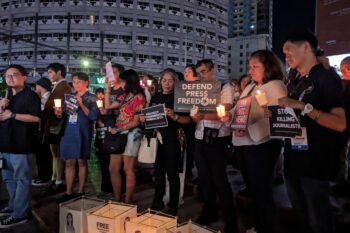DAVAO CITY (MindaNews/29 July) – Defense Secretary Voltaire Gazmin assured on Thursday that the new administration is committed to continue talking peace with rebel groups in Mindanao with a new approach — through localized peace talks.
 Gazmin, a retired military general, visited the Eastern Mindanao Command at Camp Apolinario in Panacan here for the first time as defense chief and held a command conference with military commanders in the region.
Gazmin, a retired military general, visited the Eastern Mindanao Command at Camp Apolinario in Panacan here for the first time as defense chief and held a command conference with military commanders in the region.
Under the new administration, he stressed that the peace process will continue but it will be based on justice as pointed out by President Benigno Simeon Aquino III.
“In the case of the Moro Islamic Liberation Front, we will not forget the offenses,” Gazmin told reporters. He was referring to MILF commanders Ameril Ombra Kato, operating in Maguindanao and North Cotabato, and Abdulrahman Macapaar alias Commander Bravo, operating in the Lanao provinces.
They were accused of torching of civilian houses and killing of civilians in August 2008 when hostilities erupted in North Cotabato, Maguindanao, Lanao del Sur and Lanao del Norte following the aborted signing of the controversial Memorandum of Agreement on Ancestral Domain (MOA-AD).
In the case of the New People’s Army (NPA), Gazmin bared that the government is bent on resuming the aborted talks despite the Communist Party of the Philippines’ (CPP) rejection of the government’s proposal to declare ceasefire first before the resumption of talks.
“If that is their position, we will still continue our security operations, although there are some local NPA commanders who are willing to talk to us because they want to live normally,” he claimed, adding that they are also encouraging other NPA leaders to cooperate with the government.
Gazmin said they are also supporting grassroots and local peacebuilding initiatives, particularly in areas affected by hostilities between the government and MILF.
The Armed Forces of the Philippines (AFP), he said, is now beefing up its non-combat operations, also known as civil military operations (CMO).
“I have told the troops to go down to the communities and show the services of the government to the people. This will eventually encourage the people to cooperate with the government,” the defense chief added.
Gazmin believes that this approach is effective in resolving the insurgency problem in the country. “The NPAs cannot stop us from talking to their ground commanders,” he stressed.
AFP Chief of Staff Lt. Gen. Ricardo David, on the other hand, claimed that the Oplan Bantay Laya 1 and 2 that ended on June 30 were both successful since it started in 2002.
David claims to have reduced the NPA rebels from about 25,000 in 1996 to about 5,000 until it ended this June 30.
But he admitted that there are still areas of concern that need to be addressed, referring to areas where the AFP need to strengthen its non-combat operations. These include the Davao provinces and Compostela Valley, he said.
National Democratic Front spokesperson Jorge “Ka Oris” Madlos claims that the NPA has 109 guerilla fronts in Mindanao, at least three of them in Compostela Valley province alone. (Keith Bacongco / MindaNews)
